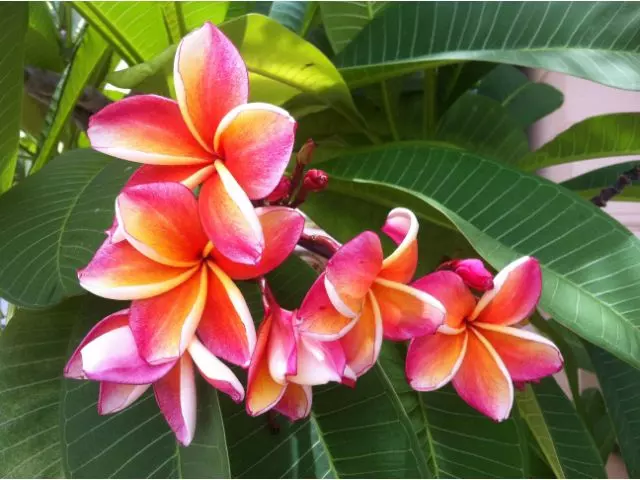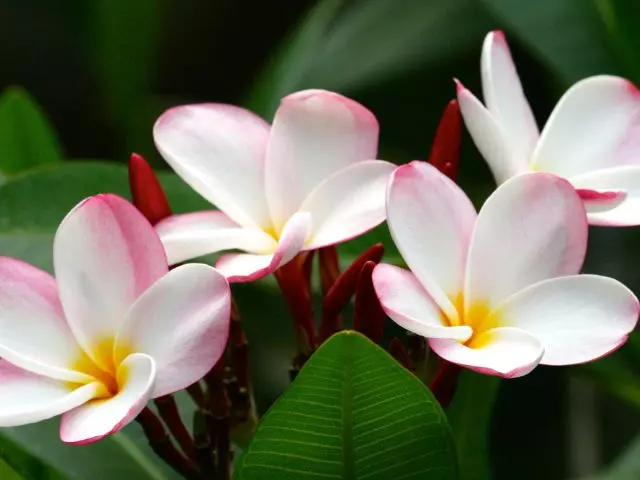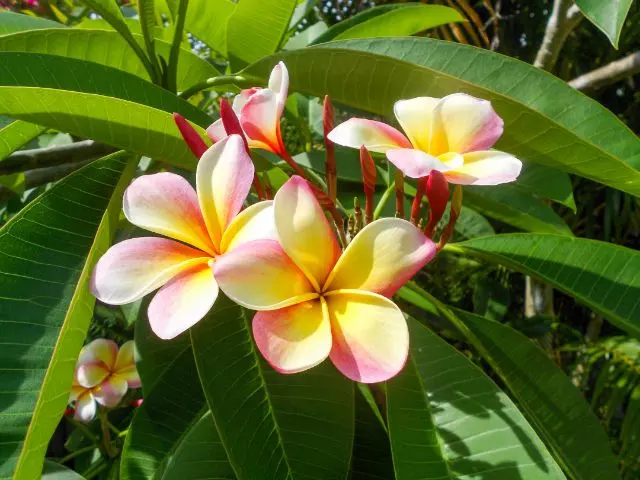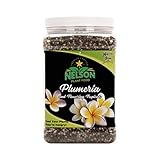Plumerias, also known as Frangipani, are small tropical trees originating from tropical America, from Brazil to Mexico, but have gained popularity worldwide due to their beautiful and fragrant flowers. If you are wondering, What is the best Plumeria fertilizer? You are about to find all the answers in this article. Throughout this article, I will explain everything in detail about Plumeria fertilizer.
According to the University of Florida Plumeria trees typically thrive in USDA hardiness zones 10b to 11. Still, with proper care, they can be grown in various climates. For those who live outside the recommended hardiness zones, it is normal to keep Plumeria in pots to protect it during the winter.
Plumerias have specific nutritional requirements. They benefit from a fertilizer that is high in phosphorus and low in nitrogen. This nutrient balance promotes robust blooming and flower development while preventing excessive foliage growth. Continue reading to know all about Plumeria fertilizer.
Table of Contents
What Kind of Fertilizer for Plumeria
Plumeria needs fertilizers with high phosphorus and low nitrogen content. Phosphorus favors the development of flowers in Plumeria, so fertilizers rich in phosphorus should be used. Phosphorus is crucial for promoting root development, flowering, and fruiting.
Nitrogen promotes plant and foliage growth. If you are growing your Plumeria in pots, you will not need to grow so much to be able to keep your Plumeria in pots. That is why you should choose fertilizers with low nitrogen content when fertilizing your Plumeria.
Potassium contributes to overall plant health by regulating water uptake and transpiration. It also helps in enzyme activation, supporting various plant metabolic processes. Adequate potassium levels enhance disease resistance, drought tolerance, and overall stress tolerance.
Therefore, you should use an NPK fertilizer for Plumeria with high phosphorus and low potassium and nitrogen content. For example, a good NPK fertilizer 5-30-5 will be ideal for fertilizing Plumeria.
NPK stands for Nitrogen, Phosphorus, and Potassium. In the case of Plumeria fertilizer, 5-30-5 means that the fertilizer contains 5% nitrogen, 30% potassium, and 5% phosphorus. The rest are other minerals and nutrients that Plumeria also needs to grow and develop properly.

Best Plumeria Fertilizer
Before fertilizing Plumeria, the most important thing is to measure the soil pH. Plumerias need a pH between 5.5 and 6 to develop and grow correctly. With a pH outside these values, the Plumeria will not absorb the fertilizer correctly or develop incorrectly. In this case, the fertilizer will not be well-used by the plant.
The most efficient methods for decreasing soil pH involve the introduction of elemental sulfur, aluminum sulfate, and iron sulfate, along with using natural soil acidifiers like peat moss, well-decomposed manure, or compost.
The optimal approach for raising soil pH involves utilizing lime-based substances like dolomite and agricultural lime. Alternative techniques like baking soda, crushed eggshells, or wood ashes can also serve this purpose.
Once the pH of the soil is correct, you can fertilize the Plumeria. As I mentioned before, the best fertilizer for Plumeria is an NPK 5-30-5 fertilizer. Having an abundance of phosphorus will favor the flowering of the Plumeria.
If you cannot find a Plumeria fertilizer with these characteristics, look for an alternative that contains only 5% nitrogen and between 30 to 50% phosphorus. The potassium level can go from 5 to 15% approximately.
- PLUMERIA PLANT FOOD: Nelson Plumeria and All Flowering Tropical Evergreen Plants Food featuring (NPK) Nitrogen (5%), Phosphate (30%), Soluble Potash K20 (5%). Balanced ingredients encourage regrowth after pruning. Contains five Nitrogen sources to ensure a constant feed. Higher Phosphorus produces more blooms, while added elemental Sulfur helps increase soil acidity. Specific micronutrients promote brilliant and colorful blooms.
- TROPICAL PLANT FOOD: Excellent source of nutrients and minerals for in-ground and container grown trees, shrubs, evergreens including but not limited to: Plumeria, Frangipani, Lei Plant, Ground Orchids, Tree Ferns, Peace Lily, Crotons, Plumbago, Stephantis, Mexican Firebrush, Candletree, Ixora.
- PATIO INDOOR OUTDOOR PLANT FERTILIZER: Helps promote more beautiful and lash green foliage growth due to balance nutrition. Important micronutrients allow plants to active maximum health.
When to Fertilize Plumeria
Fertilizing Plumeria plants should be timed to coincide with their active growing season. Plumerias generally enter a period of active growth and flowering during the warmer months, typically from late spring through summer.
As the weather starts to warm up and you see new growth emerging, it is a good time to begin fertilizing. That is usually in late spring. Fertilize once or twice a month during this period to support the initial growth spurt.
Continue with regular fertilization as your Plumerias continue to grow and develop new leaves and stems. That is when the plants are gearing up for their main blooming season.
During the peak of summer, Plumerias are usually in full bloom, showcasing their beautiful flowers. Keep up with regular fertilization to provide the nutrients needed for sustained blooming.
As summer starts transitioning into fall, you can gradually reduce the frequency of fertilization. That will help signal the plant that it’s time to slow down growth and prepare for the dormant period.
In late fall and winter, Plumerias often go dormant during the colder months. That is when you should stop fertilizing altogether. The plant’s metabolic activity slows down and doesn’t require as many nutrients.

How to Fertilize Plumeria
There are granular and liquid fertilizers. Each Plumeria fertilizer should be applied according to the manufacturer’s directions. I use slow-dissolving granular fertilizer to fertilize my Plumerias. Below I will explain how to fertilize Plumeria using the NPK 5-30-5 fertilizer I use on my Plumerias.
| Container Size | Application Quantity |
| 1 Gallon | 2 Teaspoons |
| 5 Gallon | 2 Tablespoons |
| 10 Gallon | 3 Tablespoons |
| 15 Gallon | 4 Tablespoons |
So, let’s suppose you have your Plumeria in a 10-gallon pot. Spread 3 tablespoons of fertilizer on the substrate after applying the Plumeria fertilizer water to facilitate the dissolution and absorption of the nutrients. Repeat the same process during the growing season (spring and summer).
For Plumerias planted in the ground, spread Plumeria fertilizer evenly across the planting area and ensure thorough watering following each use. Apply at a dosage of 1 cup per 10 square feet or 3 cups per 100 square feet.
These are indications of the Plumeria fertilizer I have used for years on my plants and have always obtained excellent results. Always read the manufacturer’s instructions and ensure the soil’s pH is correct to get the most out of the fertilizer on your Plumeria.
How Often to Fertilize Plumeria
The frequency of fertilizing Plumeria plants depends on their growth stage and your fertilizer formulation. But as a general rule, the following can be said about the frequency of fertilization of Plumeria.
Young Plumerias (1-2 Years Old): During their early stages of growth, young Plumerias benefit from more frequent fertilization. Apply fertilizer every 2-4 weeks throughout the active growing season, typically from late spring to early fall.
Mature Plumerias (2+ Years Old): As Plumerias become more established, they can be fertilized less frequently. Apply fertilizer every 4-6 weeks during the active growing season.
Blooming Period: If your Plumeria is in full bloom, you can continue to fertilize at the same frequency as during the active growing season. That will give the plant the nutrients needed to sustain the blooming phase.
Dormant Season (Winter): Plumerias usually go dormant in winter. During this period, it’s best to refrain from fertilizing. The plant’s growth slows down and doesn’t require as many nutrients.
Of course, Plumeria’s fertilization frequency will depend on the type of fertilizer used and the time of year you are fertilizing your plant. Avoid over-fertilizing, which is bad for any plant, and do not fertilize in winter, which is the plant’s resting time.

Final Conclusions
In conclusion, if you want your Plumeria to grow properly and bloom as much as possible, you should apply fertilizer during the active growing season. Using the right Plumeria fertilizer will ensure that you feed your plant in a balanced way.
Remember that it is very important that the pH of the soil is adequate for the plant to absorb and take advantage of all the nutrients properly. Finally, always follow the manufacturer’s instructions and never over-fertilize. I hope this article about Plumeria fertilizer will be of great help and that you can fertilize correctly.


